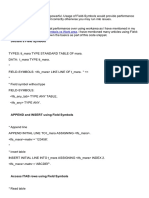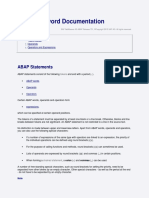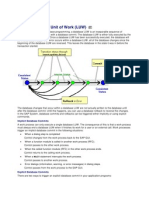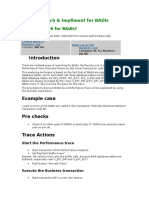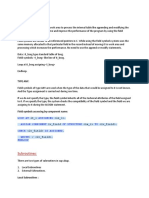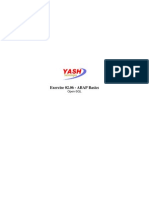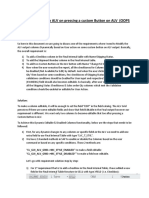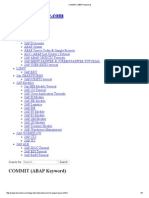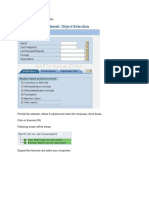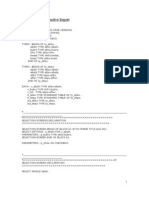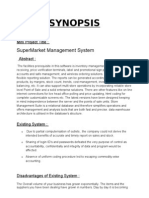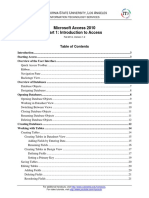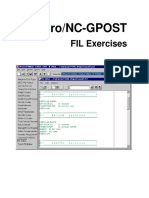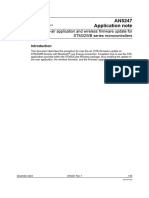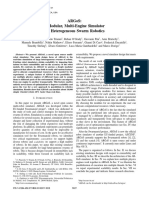ABAP Debugging Techniques
Make settings for the new debugger:
After executing the transaction, choose the Menu path Utilities -> Settings. In the User
Specific Settings, choose the Debugging tab in the ABAP editor.
he execution of the source code can be done in the follo!ing !a"s#
Single step(F5)
he progra$ is executed in steps line-b"-line and in procedures.
Execute(F6)
he progra$ is executed line-b"-line. he procedures are processed in a single step.
Return(F7)
he progra$ is executed to the point !here the control is passed bac% to the caller of
the current procedure.
Continue (F8)
he progra$ is executed up to the next brea%point. If there are no $ore brea%points
in the progra$, the s"ste$ executes the rest of the progra$ directl".
Search in internal table during debugging:
In debug $ode, gi&e the internal table na$e
'lic% on the internal table and press the find button or 'trl ( ). Put the &alues in the
search structure and press *nter.
he re+uired ro! is highlighted here.
Saving breakpoints:
If "ou need to debug the sa$e code again and ha&e a set of brea%points in place, "ou can
create a session to sa&e the brea%points and settings. ,ater this session can be loaded b"
an" user, and the sa$e set of brea%points is restored.
Path# -e! Debugger# Debugger - > Debugger Session -> Sa&e
'lassic Debugger# Debugging -> Sessions -> Sa&e
Downloading of internal tables into Ecel files:
Skip Breakpoints:
he ne! ABAP debugger gi&es an option to s%ip the first n occurrences of a brea%point.
this !ould be useful !hile debugging loops as !e $ight !ant to s%ip the first n
executions of the loop or the first n ti$es a function $odule / subroutine called.
Script recording and pla!back:
0hile debugging co$plex progra$s, or testing a user exit, !e generall" ha&e to perfor$
a set of repetiti&e actions in the debugger before reaching the point in code !e are
actuall" interested in. he actions $ight be an"thing fro$ launching a transaction to
adding a fe! lines to an internal table. An" action !e perfor$ on the SAP 1UI can be
auto$ated using Script 2ecording 3 Pla"bac%44 5ust start the 6Script 2ecorder7 b"
processing the 6'usto$i8e ,ocal ,a"out7 button 9Alt ( ):;< and select 6Script
2ecording and Pla"bac%=7 as sho!n belo!. hen hit the 6record Script7 button
and perfor$ the set of actions as "ou !ould generall" do the$. he >B script gets sa&ed
in the default SAP !or% director". ?ou can pla" it bac% using the 6Pla"bac% script7
button and the entire set of operations is perfor$ed auto$aticall".
Debugging "e#ote $unction %alls
1o to ransaction SM@A 9ransactional 2)'<.
&avigation:
&ote: It is not possible to go to a state$ent of a pre&ious *&ent !hich has alread" been
executed.
Debug a SAP Script:
1o to S*B: and open the desired la"out.
Select $enu Utilities -> Acti&ate Debugger or execute progra$ C2SDDBU1C.
o trace in a SAP script gi&e all the &alues E and press the race on/off
'lic% the Bac% Button and SAPscript debugger trace report !ill be displa"ed.
Debug a S#art for#
*xecute the transaction FSMA2)G2MSH gi&e the for$ na$e and execute it to get the
function $odule !hich is generated.
o get the *rror, execute the function Module in Debug Mode and set the Brea%point.
Debugging an A'( report
Debugging an A,> 2eport can be done onl" in the list for$at.
*xecute the A,> report to see the result
)pdate Debugging
0e $ight !ant to debug an update function $odule, but these do not run in the sa$e user
session as the debugger, hence the" cannot be debugged directl". If !e enable the
6Update debugging7 option then a separate debugging session opens after 'GMMI
0G2I. his is useful in debugging update ter$inations.
*atchpoints:
0atchpoints allo! the option of $onitoring the content of indi&idual &ariables. he
debugger stops as soon as the &alue of the $onitored &ariable changes.
In addition, conditions can be specified. he Debugger also chec%s !hether such a
condition is fulfilled.
%reate a *atchpoint:
In toolbar, clic% the create 0atchpoint button . *nter the &ariable na$e and
specif" the condition.
















